(A multi-part recap of my recent Scandinavia trip.)
For the past three days, my friends and I had explored the grand city of Stockholm, Sweden. However, there was still so much more to see! Today, thanks to our Rick Steves tour, we were visiting two of Stockholm's most popular attractions - Gamla Stan and the Vasa Museum.
 |
| At the Army Museum |
Day two of our Rick Steves tour started bright and early with guide Nina gathering everyone on the sidewalk adjacent to our hotel. I noticed a tall man dressed formally in a Panama hat, dark trench coat, and stylish scarf, lingering about the fringes of our group. Who was this dapper gentleman? Nina introduced him as a local guide named Håkan, our leader for today's walking tour.
 |
| On a random Stockholm street corner |
Håkan (pronounced "hoe-come") immediately led us down the street. About a block from our hotel we came to our tour's first stop of the day, the grounds of Sweden's Army Museum.
 |
| John Ericsson Monument |
I found out very quickly that Håkan was a wealth of knowledge about all things Swedish. He launched into a long, but interesting history of Sweden's military. The one thing I remember from this first informative talk was that early in the 1500s Sweden abruptly switched from Catholicism to embracing the Protestant church as the state religion. There was no argument or battle, everyone just woke up one morning and was told the country was now Protestant.
 |
| Street scene |
From the Army Museum, our group strolled past the Opera House to an open plaza adjacent to the harbor where my tour boat had departed the previous day. We stood in front of an impressive statue honoring Jon Ericsson, a famous Swedish-American engineer and inventor. He was known for many innovations, including the design of the first screw-propellor engine and also the first ironclad warships.
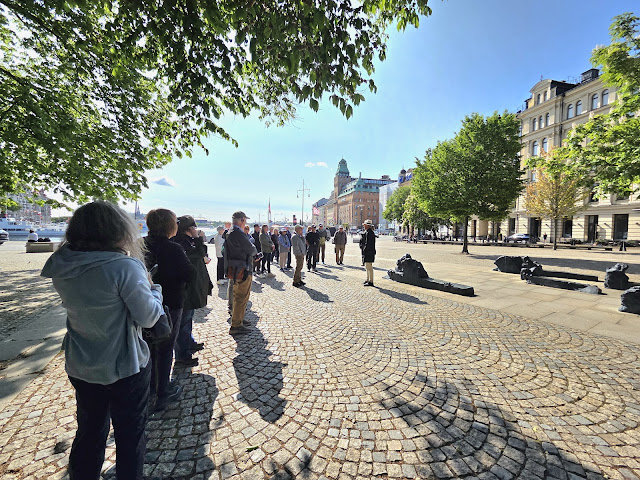 |
| Raoul Wallenberg Memorial |
Also on this same plaza was a memorial to a man named Raoul Wallenberg, a Swedish diplomat stationed in Budapest, Hungary. During World War II he was credited for saving the lives of tens of thousands of Hungarian Jews by giving them diplomatic status and housing them in diplomatic buildings. The memorial consisted of 13 bronze elongated sculptures and a large round stone orb with an inscription describing Wallenberg's heroic actions.
 |
| So. Many. Bikes |
Our tour then continued past an office building. Instead of a large parking lot for vehicles, bike racks dominated the area between the sidewalk and building face. Håkan mentioned that in Stockholm it was very common for people to commute on bicycles, even in winter. Not only bicycles, I also observed many people zipping around town using motorized scooters. With such a high volume of two-wheeled traffic, it didn't take long for me to realize that in Stockholm, you'd better not linger in the bike lane!
 |
| Saint Jacob's Church |
Past the office buildings, our tour group came to linear park. Beautifully landscaped, we followed its green paths past a unique brightly colored church that I'd noticed on yesterday's boat tour and walk around town. Håkan told us this was Saint Jacob's Church.
 |
| King Karl XII statue |
Most city parks boast sculptures of prominent countrymen, and Stockholm was no exception. Strolling through this linear park, Håkan took our group by a statue of King Karl XII. Ruling the country between 1697 and 1718, this monarch defended Sweden during the Great Northern War. I liked how a bunch of red-blooming trees added some color to the surroundings.
 |
| Beautiful bridge leading to Parliament Building |
Now entirely through the park, Håkan led our group onto a city street paralleling the harbor waters. We walked toward a lovely stone bridge. On the other side was an important Swedish building.
 |
| Parliament House |
It was the Swedish Parliament House.
 |
| Gustav II Adolf's statue |
On our way to get a closer look at the Parliament House, our group passed by another large statue situated in the middle where several roadways intersected. This was a monument to Gustav II Adolf, or Gustavus Adolphus. This man ruled Sweden in the early 1600s and was credited with raising the country into a great European power.
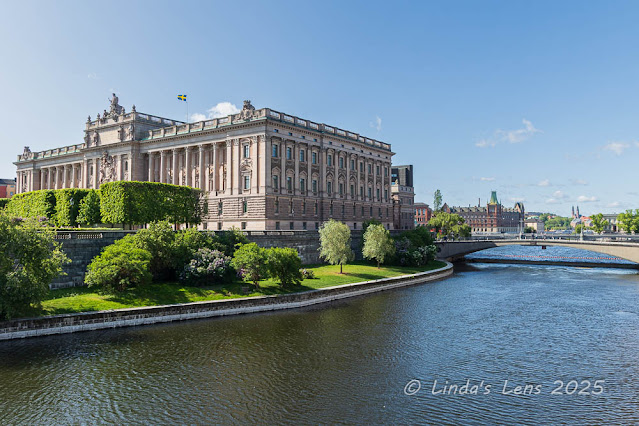 |
| Another view of Sweden's Parliament Building across the water |
Beyond the Gustav II statue, our group followed the river for even closer views of the Parliament House.
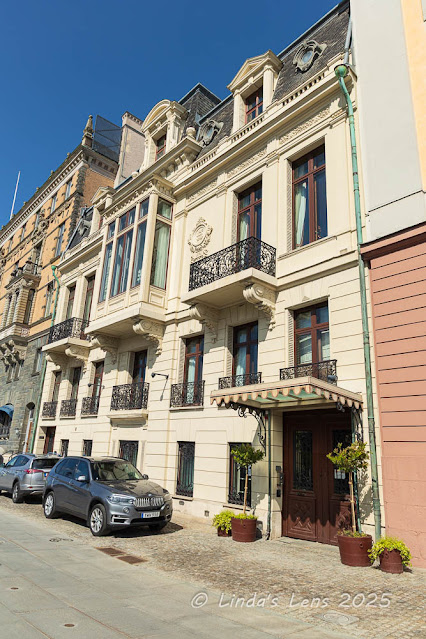 |
| Prime Minister's house |
Then Håkan led everyone further along the waterfront, past a fairly ordinary looking residence. Håkan explained that this was where Sweden's prime minister lived. It was so nondescript no one would've ever guessed it housed someone of such importance. The place wasn't overly fancy, and there were no security guards standing outside.
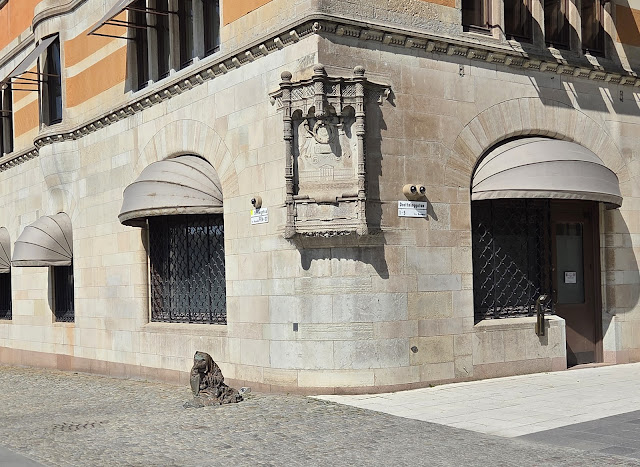 |
| Homeless Fox statue |
Half a block beyond the prime minister's residence, our group passed by a small bronze statue sited on a corner next to a building face. The statue depicted a homeless fox. Håkan explained this statue's prominent location was no accident, but had been placed on this streetcorner near the Parliament Building and prime minister's home to remind the leaders and lawmakers of the forgotten citizens - that they represent all people, even the poor.
 |
| This statue is placed near government offices |
Onward to the Parliament House! The homeless fox state happened to be at the foot of a bridge spanning the water. Across this bridge sat the stately stone building where Sweden's lawmakers assembled to govern the country.
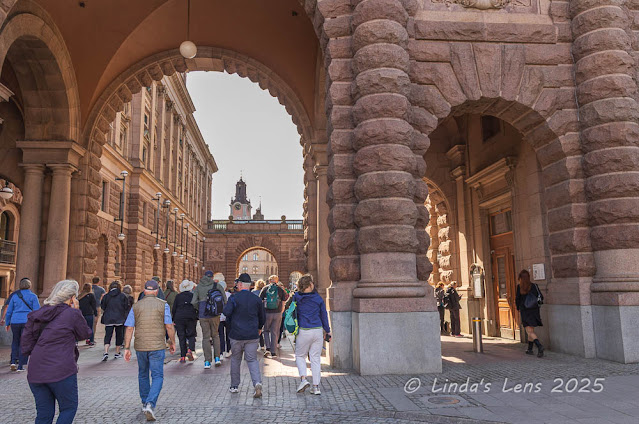 |
| Walking by the impressive Parliament Building |
A series of stone arches framed the entrance and exits to the Parliament Building. Håkan took us through the first arch, and then gathered our group in the plaza between to explain a bit about the Swedish government. Although the Swedes pay high taxes, they receive many things in return for their money - free healthcare, education through college is provided, childcare, elder care and so much more. Because the government takes care of its citizens, the majority of Swedish people are fine with paying this high tax rate.
 |
| Our group passed under many arches |
Håkan noted one spot next to a building entrance where a handful of people with signs stood. This was the designed "protest zone," a place set aside for anyone advocating their specific cause. Two people were supporting Palestine while a couple others were protesting another issue (I can't remember exactly what it was.)
 |
| The stonework is amazing |
Seeing the Parliament House close up was even more spectacular than gaping at it from across the harbor. The building displayed elaborate stone carvings on its exterior, and one entrance boasted a grand staircase leading inside. Walking through the tall arches was a very cool experience.
 |
| Storkyrkan Cathedral's pink spire |
On Parliament's opposite side was the entrance to Gamla Stan - Stockholm's Old Town. Dating back to the 13th century, this part of Stockholm was known for its narrow alleyways, cobbled streets, and unique architecture. This picturesque burg was where the visitors all flocked.
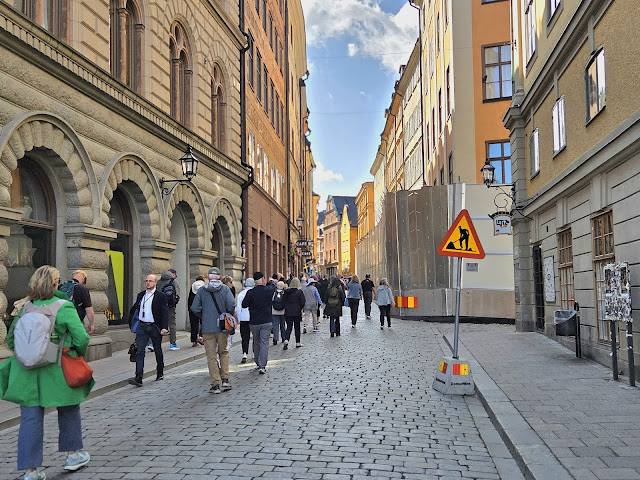 |
| Typical Gamla Stan street scene |
Almost immediately our tour group passed by several blocks of brightly-colored buildings. A tall, pink church spire towered above the rooftops. I loved Gamla Stan right away!
 |
| This place used lots of oranges! |
Gamla Stan was the touristy part of Stockholm, also known for its trendy restaurants and unique shopping. Håkan led us past several cute cafes and an entire street of souvenir shops. At this early hour, none of the retail places were open yet, but the window displays advertised many tempting items. I definitely wanted to return once our tour was over.
 |
| Gift shop window display |
Several times our group gathered in the middle of the narrow, cobbled streets listening to Håkan talk about historical events and facts about Gamla Stan. Since autos were allowed on these streets, we had to press ourselves up against the buildings a couple of times, to accommodate vehicle passage. One errant car drove by and then realized they'd made a wrong turn (darn Google maps!) Since there was no place to turn around, the driver was forced to back down the narrow lane. Håkan stepped in and calmly guided him to the next intersection.
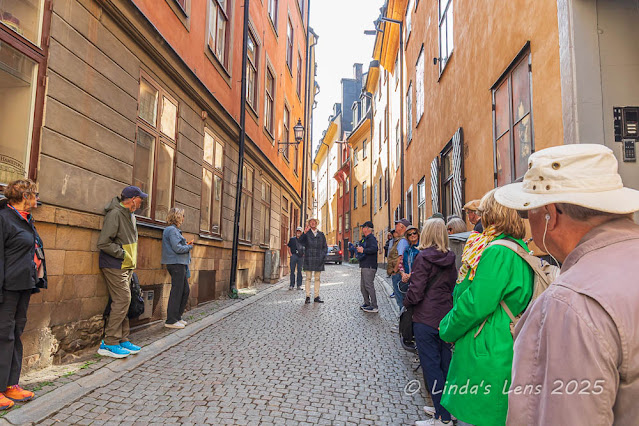 |
| Our guide Håkan explaining a bit of Gamla Stan history |
One thing I have to say about the Swedes - they were extremely patient people. At one point, I noticed a couple of ladies pushing baby carriages walking down the middle of one street, when a car came up behind them. Instead of honking the horn or revving their engine, the car's driver simply waited for the ladies to move. In the four days I was in Stockholm, I never once heard a car horn. The streets were always very quiet and tranquil.
 |
| Painted wooden horses are a thing in Sweden |
I learned that painted wooden horses are a popular souvenir item in Sweden. Nearly all the gift shops seemed to display some type of them. Then our tour passed by a museum dedicated entirely to wooden horses! Sadly, there wasn't time to go inside.
 |
| Stortorget - Gamla Stan's famous colored buildings |
Next Håkan led our group to the most visited part of Gamla Stan, Stortorget. This area consisted of a large cobblestone plaza, bordered on one side by a row of brightly colored old buildings. These buildings had all been merchant houses in the 13th century, but were now renovated with shops and cafes on their lower levels.
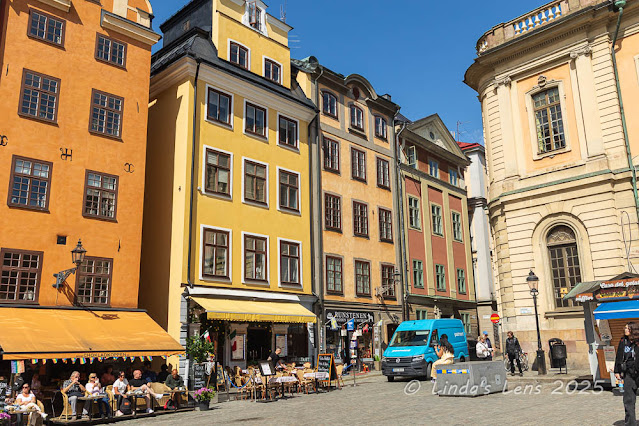 |
| More of Stortorget |
The Nobel Prize Museum was located on another side of the Stortorget plaza. It looked like an interesting place, but our group unfortunately didn't have time to visit. (I've added it to my "Second Stockholm trip" list.) We also learned that this particular square was the site of the Stockholm Bloodbath, an incident where Swedish nobility were massacred by Christian II of Denmark in November 1520. A large fountain in the square noted this tragic event.
 |
| The Nobel Prize Museum was also located here |
I really loved the brightly hued old buildings of Stortorget. Many photos were taken here, both by camera and cell phone. The buildings themselves seemed to be the main symbols of Gamla Stan. When later perusing the local gift shops, I recognized many items emblazoned with their images.
 |
| These buildings were so photogenic! |
By now we'd been walking around for the good part of two hours. It was time for a break. Håkan led our group into a building and up several flights of stairs. Then he opened a door and ushered us into an apartment. He pointed out the restroom for those in need, and then directed the rest of us to have a seat into the living room. But this wasn't just any apartment - it was Håkan's home!
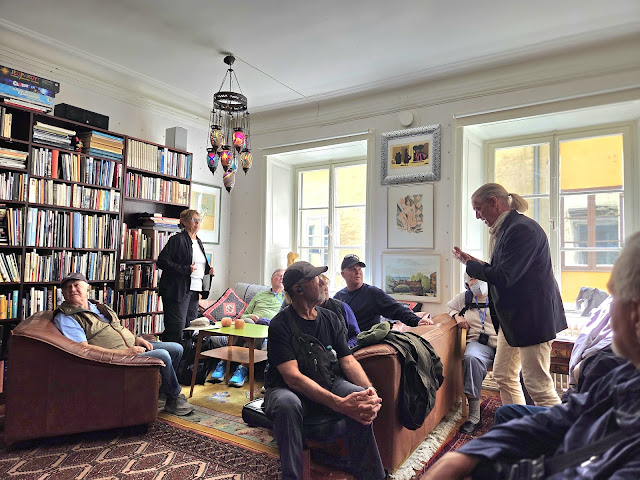 |
| Rest break in Håkan's apartment |
Our local guide opened his personal apartment to us for a rest break. I was blown away by his generosity! I also was amazed Håkan housed his family in such a small space (he raised three of his five daughters here.) We sat and rested while Håkan invited us to ask him any questions at all about Swedish life. We learned that he and his "girlfriend," the mother of his daughters, were not married. When challenged by one of our group members, he simply replied: "Why should we be married?" From Håkan we learned that many Swedish couples don't marry - unlike the US, there's really no incentive to do so.
 |
| Lovely huge tree in the heart of Gamla Stan |
After a small snack and restroom break, it was back down the stairs of Håkan's apartment for more of Gamla Stan. Not far from his home, Håkan pointed out a large tree growing in a small square, surrounded by tall buildings. Such a beautiful tree, it looked very out of place amidst all the urban hardscape.
 |
| St. George & The Dragon Statue |
We also strolled by a statue called "St. George & The Dragon." This sculpture commemorated the 1471 victory over the Danish Army in the Battle of Brunkeberg.
 |
| School kids taking a break in the statue's shadow |
There was a group of school kids, apparently also on a tour, who were taking a break around the statue's base.
 |
| Loved all the brightly colored buildings |
There was so much to see in Gamla Stan! I look tons of photographs, and it was hard to choose which ones to include in this blog post. So here's a few more that I couldn't leave out. Please enjoy these next images without commentary....
 |
| Stockholm manhole cover |
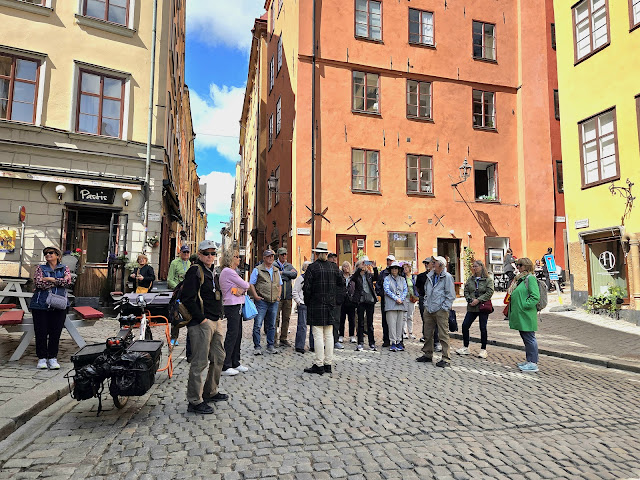 |
| I really enjoyed touring Gamla Stan |
 |
| Spire of the German Church |
 |
| Mårten Trotzigs gränd, Stockholm's narrowest street |
Towards the end of our morning's tour, Håkan directed our group to walk down a narrow crevice between two buildings. Called Mårten Trotzigs gränd, this lane had the distinction of being Stockholm's narrowest street.
 |
| The view on our way down |
And boy did it live up to its name! More like a path, this "street" was just wide enough for one person to fit between the neighboring buildings. A staircase sloped steeply downhill - you really had to pay attention to your footing while descending.
 |
| Evert Taube statue |
Our last stop of the morning's tour was at another large Gamla Stan plaza. This one was full of tables and chairs to accommodate the neighboring cafes. But
Håkan led us over to a small statue next to one building. This statue commemorated Evert Taube, a famous 20th century Swedish musician. The man was so famous his face appeared on the 50 kronor banknote. To prove this,
Håkan pulled out one of his own bills to show us.
Håkan told us that instead of politicians, Swedes honored musicians, famous actors, and artists on their money.
 |
| Ferry to Djurgården |
Sadly, our time with Håkan had now come to an end. He'd been a wonderful source of information, hands-down the best local guide I had on this entire tour. Our group bid Håkan a fond farewell and then boarded a ferry across the harbor for our afternoon's destination - the Vasa Museum.
 |
| Havin' fun on the ferry |
The ferry ride was short, about 15 minutes or so. But it passed by some of the places I'd seen on yesterday's boat tour, such as the Kastellet citadel and the restored sailing ship.
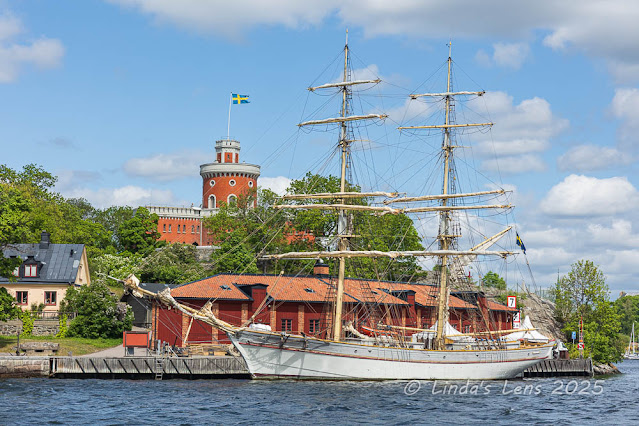 |
| Scenes from yesterday's boat tour |
It was another lovely, blue-sky day and the Stockholm cityscape views were as good as ever.
 |
| City views from the ferry |
Our ferry docked near the
Gröna Lund Amusement park. My tour-mates and I disembarked and followed Nina along a wide paved path that paralleled the harbor waters. Lots of museums were located along this path, and it was interesting to see the different subjects.
 |
| Our group walked by a number of museums |
There was a "Museum of Wrecks" that sounded interesting. There was also a Viking Museum, a contemporary art museum, and of course the ABBA Museum (that I'd seen plenty of two days ago.) But the most intriguing place we passed by was the Spirit Museum, a place celebrating Swedish drinking culture. Sadly I didn't get a chance to check it out - so it's also been added to my "second Stockholm visit" list.
 |
| This one looked interesting! |
Our tour's afternoon destination was the most popular museum and top tourist attraction in Stockholm - the Vasa Museum.
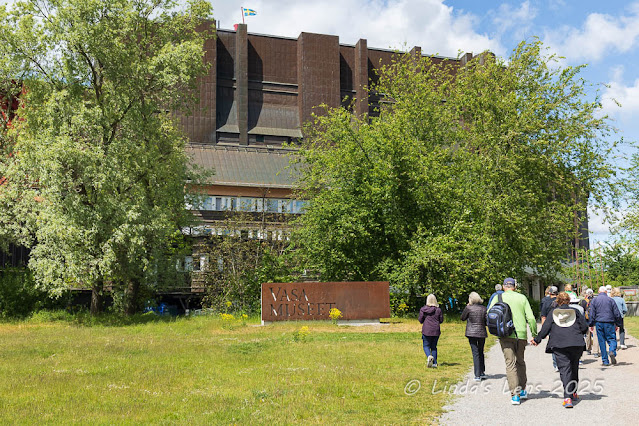 |
| But the Vasa Museum was our destination |
Since I hadn't taken advantage of the restroom facilities at Håkan's apartment, by this time I had to GO! It took awhile to get inside the Vasa Museum, and all the while I impatiently squirmed. When Nina finally got done giving us instructions for the rest of the day, I made a beeline for the WC. Kim, Debbie, and Alicia were close behind.
 |
| This Museum housed the warship Vasa |
Kim, on the other hand, was desperately in need of some food. She was feeling weak and a bit hangry, so our next stop was the museum's cafe for a late lunch break.
 |
| The Vasa was a 16th century ship that sank in Stockholm harbor |
Tummies full and bladders emptied, it was finally time to see the famous Vasa warship. Kim, Debbie, Alicia and I emerged from the museum's cafe to the stunning sight of this 17th century ship, recovered from where it sank in Stockholm harbor, restored, and now on display for all to see.
 |
| The wreck was discovered and raised in the 1960s |
King Gustav II Adolf was intent on building Sweden into one of the most feared countries in Europe. In 1625, the king signed a contract with a Dutch shipwright to build four ships. One of them, the Vasa, was planned to be the most powerful warship in the Baltic, if not the world.
 |
| The old ship was preserved and displayed in this museum |
For its time, the Vasa was a giant of a ship. It measured 69 meters (226 feet) in length, and more than 50 meters (164 feet) from keel to the top of the main mast. When outfitted with a full load - 64 cannons, 120 tonnes of ballast, and hundreds of sculptures, the ship weighed over 1200 tonnes (approximately 1300 US tons).
 |
| Colorful restored carvings from the ship's exterior |
The Vasa's maiden voyage happened on August 10th, 1628. A festive atmosphere prevailed at Stockholm harbor with the king eager to show off his mighty new warship. Spectators lined the waterways and small boats filled the harbor, all jostling to get a glimpse of the Vasa as it set sail from Stockholm.
 |
| The back end of the Vasa was filled with beautiful sculptures |
However, minutes into its first voyage, a gust of wind pushed the Vasa so far onto its port side that water began rushing into the ship's open gunports on the lower deck. Still in sight of the shipyard where it was built, the Vasa quickly began to sink. Within minutes, the ship was on the sea bed at a depth of 32 meters (about 100 feet.) Thirty people perished that day.
It was later determined that the Vasa was built much too top-heavy for carrying such a load of cannons and other weaponry. In those days, ship designs were based on past experiences, and no one used mathematics to calculate how a loaded ship might perform.
 |
| Life-size models of some sculptures were on display |
The Vasa lay on Stockholm's harbor floor for over three centuries until 1956 when a fuels engineer named Anders Franzén discovered what he thought was the shipwreck. In 1958, one of the Vasa's cannons was recovered and the ship's identity confirmed. It took another three years of planning and preparation, but on April 24, 1961, the Vasa was raised from its watery grave. The event was televised nationally on Swedish television.
 |
| This one depicts a punishment on the ship |
It took years of restoration work to prevent the ship's wood from drying out too quickly. Finally, in 1990 the Vasa was moved to its present location, this grand museum I was standing in today. To preserve the ship and its many artifacts, the museum's environment was carefully controlled. I noticed the light was dimmed considerably, I assumed in an attempt to slow any deterioration. (However, the lack of bright lighting made photography challenging. Because it took superior low light photos, I used my cell phone exclusively while in the Vasa Museum.)
 |
| View from the ship's front end |
And, wow, was that ship was an amazing sight to see! When I first heard we were visiting a restored shipwreck, it initially didn't sound very interesting. I thought maybe I'd spend an hour tops in the museum. My friends and I ended up being inside over three hours, totally enthralled by everything we saw.
 |
| Such an amazing work of art! |
The entire ship was inside this huge building. There were four floors enabling visitors to examine the Vasa from different vantages. The ship's tall masts poked out of the roof, where they were visible from the outside. Standing beside this monstrosity of a ship made me realize what a feat it was to build something of this scale back in the 1600s.
 |
| Coat of arms |
The restoration work done on the Vasa was amazing. All the intricate carvings had been lovingly preserved. Even weathered from being underwater for over 300 years, the intact ship on display was an extraordinary sight.
 |
| Model of what the Vasa looked like on her maiden voyage |
There were displays of many artifacts that had been found inside the ship - coins, dishes, pipes, everyday items that the sailors carried with them. Another display explained how these enormous ships were built back in their day. The final exhibit my friends and I took in was a very informative movie that explained how the ship sank, the effort to raise it up from the harbor, and the huge amount of restoration work that was accomplished, enabling visitors to see the Vasa for themselves.
 |
| High swing ride |
Our Rick Steves tour had left the afternoon free. We could stay at the Vasa Museum as long as we liked, and then fend for ourselves for dinner. After spending an amazing three hours at this museum, my friends and I unanimously decided we all wanted to see more of Gamla Stan. So retracing our steps to the ferry, we sailed back across the harbor.
 |
| On the ferry again, back to Gamla Stan! |
 |
| Debbie points out something interesting |
It was great to back amongst Gamla Stan's cheerful, vibrantly-colored buildings once again. Once off the ferry, we four ladies hit the street with all the souvenir stores. However, what had been a quiet, mellow area during our morning's tour was now quite busy. The area was packed with tourists, and I noticed many full tables at the cafes and restaurants.
 |
| More colorful waterside buildings |
Time to shop! Although there were a few specialty boutiques, most of the retail on this Gamla Stan street hawked souvenirs. I had great fun looking at everyone's wares anyway. However, it didn't take long before a lot of the trinkets found in these shops all began looking the same.
 |
| There was so much to see in Gamla Stan |
There were some good finds, though. Alicia bought a lovely shawl from one of the specialty stores. After searching for the shop I'd seen in the morning tour displaying cute gnomes in their window, we finally located the place and I got my gnome.
 |
| Ready to hit the souvenir shops |
Because of the Viking history in Scandinavia, many of the places here embellished upon the theme. One pub, called the Viking Bar, looked totally in character (they even served mead!) We saw lots of Viking-type souvenirs in the local shops. My hubby is a huge Minnesota Vikings fan, and I spotted a banner sporting the team logo hanging outside one of the Gamla Stan stores.
 |
| This place looked fun |
 |
| Alicia looking through some beautiful shawls |
 |
| The gang window shopping |
 |
| So many cool little alleys! |
After a couple of hours spent pounding the pavement for bargains, all four of us were ravenous. It was time to find some dinner. However, getting four people to agree on a place to eat was a bit challenging. Everyone had different desires, so we ended up doing a lot of walking and looking. Finally, when myself and Debbie were getting very hangry, my friends and I decided to try the next place we came upon. It was a deli, but seemed to have everything we needed - delicious looking sandwiches and alcoholic drinks. What more could we want?
 |
| Looking over the myriad of souvenir shops |
The deli ended up being a great place - the food was tasty and the drinks cold and flavorful. A bit of food revived us all. As we slowly made our way out of Gamla Stan, my friends and I agreed it had been another great day in Stockholm.
 |
| This photo was for my hubby - a Vikings fan! |
Tomorrow we'd bid this wonderful metropolis a sad farewell as our tour was scheduled to travel to the next country and city - Copenhagen, Denmark.
Join me as I dodge cyclists, meet Hans Christian Anderson, and learn all about the "hygge" lifestyle. Coming in my next post!







































































Hi Linda, what an amazing place!!! I love the views, the architecture, the coloured buildings. The manhole cover is the nicest I have ever seen. I love the narrow cobblestone alley. Everything is beautiful. Thank you 😊 so much for sharing your journey ❤️
ReplyDeleteWow--- That is a remarkable post! I will need another couple of trips through the whole thing. Well done!!
ReplyDelete...thanks for taking me along to see these scenes straight out of a storybook.
ReplyDeleteThe woodcarving on the ship is just awesome, I wonder how many woodcarvers did the work...many I would think! I too like the colorful buildings! Nice find on the Vikings sign:)
ReplyDeleteI would imagine that the visit to Hakan’s apartment was one of the highlights. It’s always interesting to visit a home in another country. In Canada, common law spouses have equal rights after one year of cohabitation so there is no legal advantage to marriage, and many choose not to get married. Tradition lives on, however, and there are many elaborate and expensive weddings, almost half of which wind up in the divorce courts anyway.
ReplyDeleteReally enjoying your travelogue, keep it coming!
ReplyDeleteWhat a fabulous day in this beautiful city. I spent 2 days here in 1976 and your wonderful photography and description of all you experienced had me digging for my diary. I really have little memory of all its beauty. I did visit many places you have shared. Thanks for rekindling the memories.
ReplyDelete